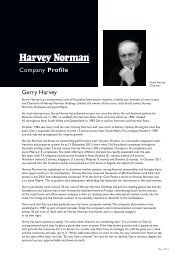annual report - Harvey Norman Company Reports & Announcements
annual report - Harvey Norman Company Reports & Announcements
annual report - Harvey Norman Company Reports & Announcements
Create successful ePaper yourself
Turn your PDF publications into a flip-book with our unique Google optimized e-Paper software.
NOTES TO THE FINANCIAL STATEMENTS (CONTINUED)<br />
34.<br />
116<br />
Financial Risk Management (continued)<br />
(c) Credit Risk<br />
Credit risk refers to the loss that the consolidated entity would incur if a debtor or other counterparty fails to perform<br />
under its contractual obligations.<br />
Credit risk arises from the financial assets of the consolidated entity, which comprise trade and non-trade debtors,<br />
consumer finance loans and finance lease receivables. The consolidated entity‟s exposure to credit risk arises from<br />
potential default of the counter party, with a maximum exposure equal to the carrying amount of these instruments.<br />
The consolidated entity‟s policies to limit its exposure to credit risks are as follows:<br />
Conducting appropriate due diligence on counterparties before entering into an arrangement with them. It is<br />
the consolidated entity‟s policy that all customers who wish to trade on credit terms are subject to credit<br />
verification procedures including an assessment of their independent credit rating, financial position, past<br />
experience and industry reputation. Risk limits are set for each individual customer in accordance with<br />
parameters set by the Board. These risk limits are regularly monitored; and<br />
For finance lease receivables or non-trade debts receivable from related parties and other unrelated persons,<br />
the consolidated entity obtains collateral with a value equal or in excess of the counterparties‟ obligation to the<br />
consolidated entity.<br />
The consolidated entity minimises concentrations of credit risk by undertaking transactions with a large number of<br />
debtors in various countries and industries. In addition, receivable balances are monitored on an ongoing basis.<br />
The credit risk on liquid funds and derivative financial instruments is limited because the counterparties are banks with<br />
high credit-ratings assigned by international credit-rating agencies.<br />
The major geographic concentration of credit risk arises from the location of the counterparties to the consolidated<br />
entity‟s financial assets as shown in the following table:<br />
C O N S O L I D A T E D<br />
2012 2011<br />
Location of credit risk $000 $000<br />
Australia 992,199 1,043,402<br />
New Zealand 20,973 20,246<br />
Asia 10,362 11,696<br />
Slovenia and Croatia 2,963 2,249<br />
Ireland and Northern Ireland 2,032 2,177<br />
Total<br />
(d) Liquidity Risk<br />
1,028,529<br />
1,079,770<br />
Liquidity risk includes the risk that, as a result of the consolidated entity‟s operational liquidity requirements:<br />
the consolidated entity will not have sufficient funds to settle a transaction on the due date;<br />
the consolidated entity will be forced to sell financial assets at a value which is less than what they are worth; or<br />
the consolidated entity may be unable to settle or recover a financial asset at all.<br />
To help reduce these risks, the consolidated entity:<br />
has readily accessible standby facilities and other funding arrangements in place; and<br />
maintains instruments that are tradeable in highly liquid markets.



